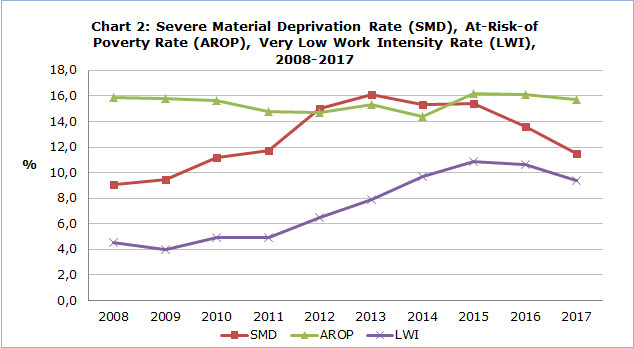25.2% of the population or 214,636 Cypriot citizens were at risk of poverty in the fiscal year of 2016, according to a Statistical Service research.
Namely, 25.2% of the population was living in households whose disposable income was below the at-risk-of-poverty threshold or was living in severely material deprived households or was living in households with very low work intensity.
However, these figures showed an improvement in comparison with the previous year which reached 27.7%.
This improvement is reflected both in the percentages of men and women, with 24.0% και 26.4% respectively, with women maintaining throughout the years their unfavorable position in respect to men.
According to Eurostat, the country with the highest at-risk-of-poverty or social exclusion levels in the European continent, for 2016 was FYROM with 41.4% of its population at risk of poverty.
The country with the lowest level was Iceland with 12.2%.
Greece was at 35.6%, while the UK was at 22.2%.


Definitions:
At-risk-of-poverty or social exclusion rate (AROPE): At-risk-of-poverty or social exclusion rate is the percentage of the population who are: at risk of monetary poverty or severely material deprived or living in a household with a very low work intensity. Persons are only counted once even if they are present in several sub-indicators.
At-risk-of-poverty threshold: is set at 60 % of the national median equivalised disposable income, which is calculated by dividing the total disposable income of the household (total disposable income of all its members after social transfers) by the equivalised household size, which is calculated using the following weights: First adult=1,0 unit, second and each subsequent household member aged 14 years and over=0,5 and each household member aged under 14=0,3. The household equivalent size is the sum of the weights of its members.
At-risk-of-poverty rate (AROP): The at-risk-of-poverty rate is the share of persons with an equalized disposable income (after social transfers) below the at-risk-of-poverty threshold. It measures relative poverty and not absolute poverty.
Severe material deprivation (SMD): Severely material deprived is the population living in conditions severely constrained by a lack of resources. They experience at least 4 out of 9 of the following deprivation items: Cannot afford 1) to pay rent or utility bills or loans 2) keep home adequately warm, 3) face unexpected expenses, 4) eat meat, fish or a protein equivalent every second day, 5) a week holiday away from home, 6) a car, 7) a washing machine, 8) a colour TV, or 9) a telephone.
Very low work intensity (LWI): The percentage of the population aged 0-59, that was living in households whose adults (aged 18-64) worked less than 20% of their work potential during the past year.
Work Intensity (WI): The work intensity of a household is the ratio of the total number of months that all household members aged 18-64 (excluding dependent children) have worked during the income reference year and the total number of months the same household members theoretically could have worked in the same period.






